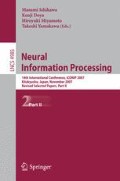Abstract
The suprachiasmatic nucleus(SCN) is a self-sustaining circadian rhythm generator in mammals. SCN neurons exhibit irregular and complex firing activity, but their firing rates display well-defined deterministic behavior with a periodicity of 24 hours. Their underlying mechanisms are still unclear. In this study, we aim to develop the computational model using NEURON, a software package for biological neuron simulation, to examine channel contributions to circadian rhythms. We found that SCN neurons produced circadian rhythms of firing activity through an interplay of various channels, including the potassium and sodium channels.
Access this chapter
Tax calculation will be finalised at checkout
Purchases are for personal use only
Preview
Unable to display preview. Download preview PDF.
References
Inouye, S.I.T., Kawamura, H.: Persistence of Circadian Rhythmicity in a Mammalian Hypothalamic“Island”Containing the Suprachiasmatic Nucleus. Proceedings of the National Academy of Sciences 76(11), 5962–5966 (1979)
Reppert, S.M., Weaver, D.R.: Molecular Analysis Of Mammalian Circadian Rhythms. Annual Review of Physiology 63(1), 647–676 (2001)
References, S., Kim, Y., Dudek, F.: Membrane properties of rat suprachiasmatic nucleus neurons receiving optic nerve input. J Physiol 464, 229–243 (1993)
de Jeu, M., Hermes, M., Pennartz, C.: Circadian modulation of membrane properties in slices of rat suprachiasmatic nucleus. Neuroreport 9(16), 3725–3729 (1998)
Thomson, A.M., West, D.C., Vlachonikolis, I.G.: Regular firing patterns of suprachiasmatic neurons maintained in vitro. Neurosci. Lett. 52(3), 329–334 (1984)
Thomson, A.M., West, D.C.: Factors Affecting Slow Regular Firing in the Suprachiasmatic Nucleus In Vitro. Journal of Biological Rhythms 5(1), 59 (1990)
Jackson, A.C., Yao, G.L., Bean, B.P.: Mechanism of Spontaneous Firing in Dorsomedial Suprachiasmatic Nucleus Neurons. Journal of Neuroscience 24(37), 7985–7998 (2004)
Kononenko, N.I., Medina, I., Dudek, F.E.: Persistent subthreshold voltage-dependent cation single channels in suprachiasmatic nucleus neurons. Neuroscience 129(1), 85–92 (2004)
Reppert, S.M., Weaver, D.R.: Coordination of circadian timing in mammals. Nature 418, 935–941 (2002)
Pennartz, C.M.A., Bierlaagh, M.A., Geurtsen, A.M.S.: Cellular Mechanisms Underlying Spontaneous Firing in Rat Suprachiasmatic Nucleus: Involvement of a Slowly Inactivating Component of Sodium Current. Journal of Neurophysiology 78(4), 1811–1825 (1997)
Kononenko, N.I., Shao, L.R., Dudek, F.E.: Riluzole-Sensitive Slowly Inactivating Sodium Current in Rat Suprachiasmatic Nucleus Neurons. Journal of Neurophysiology 91(2), 710–718 (2004)
Taddese, A., Bean, B.P.: Subthreshold Sodium Current from Rapidly Inactivating Sodium Channels Drives Spontaneous Firing of Tuberomammillary Neurons. Neuron 33(4), 587–600 (2002)
Itri, J.N., Michel, S., Meijer, J.H., Colwell, C.S.: Fast delayed rectifier potassium current is required for circadian neural activity. Nature Neuroscience 8, 650–656 (2005)
Kuhlman, S.J., McMahon, D.G.: Rhythmic regulation of membrane potential and potassium current persists in SCN neurons in the absence of environmental input. Eur J Neurosci 20(4), 1113–1117 (2004)
Meredith, A.L., Wiler, S.W., Miller, B.H., Takahashi, J.S., Fodor, A.A., Ruby, N.F., Aldrich, R.W.: BK calcium-activated potassium channels regulate circadian behavioral rhythms and pacemaker output. Nature Neuroscience 9, 1041–1049 (2006)
Pitts, G.R., Ohta, H., McMahon, D.G.: Daily rhythmicity of large-conductance Ca 2-activated K currents in suprachiasmatic nucleus neurons. Brain Research 1071(1), 54–62 (2006)
Pennartz, C.M.A., de Jeu, M.T.G., Bos, N.P.A., Schaap, J., Geurtsen, A.M.S.: Diurnal modulation of pacemaker potentials and calcium current in the mammalian circadian clock. Nature 416, 286–290 (2002)
Colwell, C.S.: Circadian modulation of calcium levels in cells in the suprachiasmatic nucleus. European Journal of Neuroscience 12(2), 571–576 (2000)
Ikeda, M., Sugiyama, T., Wallace, C.S., Gompf, H.S., Yoshioka, T., Miyawaki, A., Allen, C.N.: Circadian Dynamics of Cytosolic and Nuclear Ca2+ in Single Suprachiasmatic Nucleus Neurons. Neuron 38(2), 253–263 (2003)
Lundkvist, G.B., Kwak, Y., Davis, E.K., Tei, H., Block, G.D.: A Calcium Flux Is Required for Circadian Rhythm Generation in Mammalian Pacemaker Neurons. Soc Neuroscience (2005)
Leloup, J.C., Goldbeter, A.: Toward a detailed computational model for the mammalian circadian clock. Proceedings of the National Academy of Sciences 100(12), 7051–7056 (2003)
Smolen, P., Baxter, D.A., Byrne, J.H.: Modeling Circadian Oscillations with Interlocking Positive and Negative Feedback Loops. Journal of Neuroscience 21(17), 6644 (2001)
Gonze, D., Halloy, J., Goldbeter, A.: Deterministic Versus Stochastic Models for Circadian Rhythms. Journal of Biological Physics 28(4), 637–653 (2002)
Kononenko, N.I., Dudek, F.E.: Noise of the slowly inactivating Na current in suprachiasmatic nucleus neurons. Neuroreport 16(9), 981–985 (2005)
Kononenko, N.I., Dudek, F.E.: Mechanism of Irregular Firing of Suprachiasmatic Nucleus Neurons in Rat Hypothalamic Slices. Journal of Neurophysiology 91(1), 267–273 (2004)
Gillette, M.U., Medanic, M., McArthur, A.J., Liu, C., Ding, J.M., Faiman, L.E., Weber, E.T., Tcheng, T.K., Gallman, E.A.: Intrinsic neuronal rhythms in the suprachiasmatic nuclei and their adjustment. Ciba Found Symp 183, 134–144 (1995)
Author information
Authors and Affiliations
Editor information
Rights and permissions
Copyright information
© 2008 Springer-Verlag Berlin Heidelberg
About this paper
Cite this paper
Kim, H., Jeong, J. (2008). Computational Modeling of Circadian Rhythms in Suprachiasmatic Nucleus Neurons. In: Ishikawa, M., Doya, K., Miyamoto, H., Yamakawa, T. (eds) Neural Information Processing. ICONIP 2007. Lecture Notes in Computer Science, vol 4985. Springer, Berlin, Heidelberg. https://doi.org/10.1007/978-3-540-69162-4_97
Download citation
DOI: https://doi.org/10.1007/978-3-540-69162-4_97
Publisher Name: Springer, Berlin, Heidelberg
Print ISBN: 978-3-540-69159-4
Online ISBN: 978-3-540-69162-4
eBook Packages: Computer ScienceComputer Science (R0)

